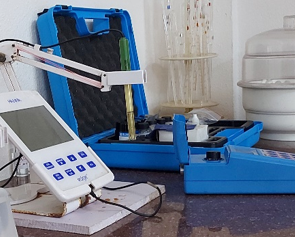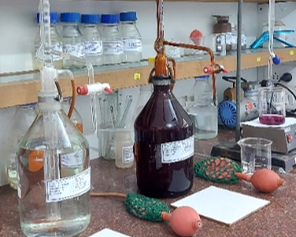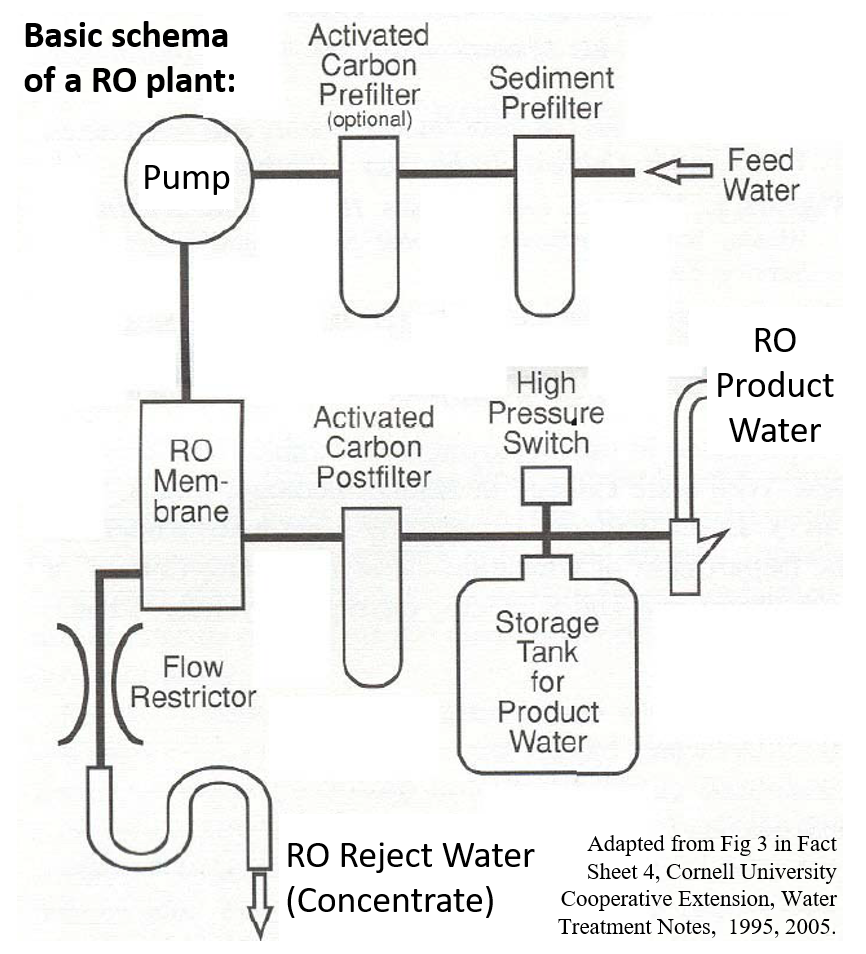Reverse osmosis reJect water Minerals (RJM)
Scope:

Physical & Sensory Parameters:
pH Value, Electrical Conductivity (EC) & Total Dissolved Solids by Gravimetry (TDSG).

Chemical Parameters:
Total hardness of water (THW), Calcium (Ca) & Magnesium (Mg); Nitrate (NO3); Chloride, Sulfate, Phosphate, Iron (Fe) & Manganese (Mn), Sodium (Na) & Boron.
Total parameters: 3 + 11 = 14
Rationale:

Reverse Osmosis (RO) technology is used extensively to produce water for various purposes. RO purifiers are high pressure semipermeable membrane systems. Basic schema of a RO system consists of pre- and post-treatment units around the core RO unit. Pretreated water is fed into RO unit under high pressure. Water that permeates through the RO membrane comes out as the product water, and the remaining concentrated water comes out as the reject water. Usually, the proportion of reject water is substantially more than the product water. For every litre of product water there may be 3 to 5 litres of reject water, depending on mineral content of feed water, desired life of RO membrane and various other operational parameters. Thus, RO plants produce substantial quantity of reject water known as reverse osmosis concentrate (ROC) or RO reject. The reject water contains salts in feed water, and chemicals used in pre-treatment process. The concentration of minerals in RO reject is depends on mineral profile of the feed water, type of RO membrane, pressure gradient and recovery rate of the system. RO reject should be put to appropriate use and/or disposed of in an environment friendly manner. RO reject water let out to street sewers and surface water bodies, should satisfy general environmental standards for effluent water. Testing of RO reject water is necessary to assess their usefulness for various intended use cases. Monitoring of reject water parameter also helps in assessing performance and health of the RO system.
In RJM, we have packaged a minimal set of general chemical parameters to characterise mineral content of RO Reject Water. The test results would be helpful for RO plant operators, to explore potential use cases and plan for appropriate disposal.
Environmental Guidelines for Discharge of Effluents to Public Sewers and Surface Water Bodies:
The General Standards for Discharge of Environmental Pollutants Part-A: Effluents issued by the Central Pollution Control Board (CPCB) would be relevant for discharge of RO Reject to inland surface water bodies such and streams, rivers, lakes and reservoirs and to public sewers. This table lists 39 parameters. However, many of the listed parameters may not be of relevance for to RO Reject water. For example; RO Plant designs invariably include pre-treatment units to remove suspended solids, chlorine, odour, hydrogen sulfide, etc. On the other hand, phosphate containing antiscalants are used in RO plants depending on hardness and mineral profile of feed water. Table 1 includes selected parameters from the general standard, that may of relevance for routine monitoring of RO rejects meant to be discharged to inland water bodies or public sewers.
| Sl | Parameter | Unit | Limitn. Type | Inland Surface Water | Public Sewers |
|---|---|---|---|---|---|
| pH | pH Value | Maximum | 5.5 to 9.0 | 5.5 to 9.0 | |
| Nitrate-Nitrogen as N | mg/L | Maximum | 10.0 | ||
| Phosphates as P | mg/L | Maximum | 5.0 | ||
| Fluoride | mg/L | Maximum | 2.0 | 15.0 | |
| Iron | mg/L | Maximum | 3.0 | 3.0 | |
| Manganese | mg/L | Maximum | 2.0 | 2.0 | |
| Source:https://cpcb.nic.in/GeneralStandards.pdf | |||||
Utilization of RO Reject for Agriculture/Horticulture:
Salinity (electrical conductivity & TDS), nitrate nitrogen, chlorides, sodium adsorption ratio (SAR), and boron are important parameters to assess suitability of irrigation water. Computation of SAR requires testing for calcium and magnesium. According IS11624-1986 (Guidelines for the quality of irrigation water), adverse effects of salinity can be classified as; (a) low (EC<1500 µ Siemens/cm, (b) medium (EC: 1500-3000 µS/cm), (c) high (EC: 3000-6000 µS/cm), and (d) very high (EC>6000 µS/cm). Table 2 shows the Food and Agriculture Organization (FAO) guidelines for interpreting quality of irrigation water. According to IS11624-1986, the suitability of an irrigation water depends on several factors, such as, soil type, plant characteristics, irrigation method, drainage, apart from water quality. Hence suitability of reject water for specific crops and plantations should be interpreted in consultation with appropriate agriculture/horticulture specialists.
| Sl | Parameter | Unit | Nature of Irrigation Problem |
Degree of Problem | ||
|---|---|---|---|---|---|---|
| None | Increasing | Severe | ||||
| 1 | Electrical Conductivity | μS/cm | Salinity | < 750 | 750 - 3000 | 3000 |
| Permeability | > 500 | 500 - 200 | < 200 | |||
| 2 | Sodium, Ca & Mg | Adj SAR | Specific ion toxicity, affecting susceptible crops. |
< 3.0 | 3.0 - 9.0 | > 9.0 |
| 3 | Chloride | meq/L | < 4.0 | 4.0 - 10.0 | > 10.0 | |
| 4 | Boron | mg/L | < 0.75 | 0.75 - 2.0 | > 2.0 | |
| 5 | Nitrate-Nitrogen | mg/L | Miscellaneous, affecting susceptible crops |
< 5.0 | 5.0 - 30.0 | > 30.0 |
| Note: Electrical conductivity values given as milli mhos/cm in the original paper has been converted to µ Siemens/cm (1 mmho =1000 µS). Siemens is the standard international unit of electrical conductance synonymous with the older term of ‘mho’. | ||||||
| Source: Table-1 in Ayers RS and Westcot DW; FAO 1985. | ||||||
Fish Farming with RO Reject Water:
RO reject water can be used for certain fish farming tolerant species. For example; the freshwater Tilapia fish is well adapted to and can survive in comparatively higher salinity of RO reject water. However, dilution with fresh water may be needed in some cases, depending on the level of reject water salinity, species of Tilapia and other environmental factors. Certain species of Cyanobacteria, for example, Spirulina maxima and Spirulina platensis are capable of coping with high salt concentrations and provide valuable nutrients to Tilapia species (Sanchez et al. 2015; Vaishnav et al. 2023).
Reusing RO Reject for Cement Bricks Manufacture:
RO reject water can be easily utilized as mixing water in production of CSA cement bricks. However, RO reject cannot be used with concrete for embedding steel structure, since the high concentration of chloride may result in rusting (Vaishnav et al. 2023; Lee et al. 2019).
Sample - Collection, Storage & Transportation:
Follow methods of sampling specified in IS3025pt1:1987 for chemical tests and in IS 1622 : 1981 for bacteriological tests. Use a 1L clean and dry clear or amber colour glass or polypropylene bottle (CBWS / ABWS) for chemical lab sample, and a 250 ml clean sterile bottle (CSB) for bacteriological sample. Collect from the RO Reject water delivery pipe or reject water storage tank tap, if any.
Information About Source, Context, Intended Use & Concerns:
Provide as much detail as you can about the supplier, batch number, bottling date, date of opening of bottle, etc. Mention about intended use of the water, the reason why you are ordering the test, as well as doubts and concerns, if any. These information help in interpretation of test results. Occasionally, the IHS Laboratory may contact you for clarifications and additional information about the source and its environment, to help interpretation of test results.
Test Method & Duration:
Physical and chemical characteristics of water sample are tested according appropriate parts of the IS3025 and/or American Public Health Association (APHA). Test report will be available in 3 to 5 days.



To pick up sample collection bottle and/or schedule collection of samples: Email: ihslab@ihs.org.in with your address and contact telephone; OR WhatsApp: +919848011251; Or Call: 23211013/4.
References:
- CPCB. General Standards for Discharge of Environmental Pollutants Part-A: Effluents. Rule 3A Schedule-VI in: GoI. The Environment (Protection) Rules. New Delhi: Ministry of Environment and Forests (MoEF), Government of India (GoI); 1986. https://cpcb.nic.in/GeneralStandards.pdf
- Ning Robert Y. Chemistry in the Operation and Maintenance of Reverse Osmosis Systems. Chapter 4 in: Ning Robert Y. Advancing Desalination. London: Intech Open; 2012 Sep 14; pp. 85-95. https://www.intechopen.com/chapters/37328
- Vaishnav Jyoti; Soloman Prama Esther; Lal Chhagan, and Jain Pankaj Kumar. RO Reject Water Characteristics, Environmental Impacts and Management. Jurnal Kejuruteraan. 2023; 35(3):557-566. https://journalarticle.ukm.my/22174/1/kjt_3.pdf
- Ayers RS and Westcot DW. Water quality for agriculture. Rome, Italy: Food and Agriculture Organization of the United Nations (FAO); 1985. https://www.fao.org/4/T0234e/T0234e00.htm
- Lee Hwan; Jeon Dongho; Song Haemin; Sim Sung Won; Kim Dohoon; Yu Joan; Cho Kyung Hwa, and Oh Jae Eun. Recycling of Reverse Osmosis (RO) Reject Water as a Mixing Water of Calcium Sulfoaluminate (CSA) Cement for Brick Production. Applied Sciences. 2019; 9(23):5044. https://www.mdpi.com/2076-3417/9/23/5044
- Sanchez AS; Nogueira IBR, and Kalid RA. Uses of the reject brine from inland desalination for fish farming, Spirulina cultivation, and irrigation of forage shrub and crops. Desalination. 2015 May 15; 364:96-107. https://doi.org/10.1016/j.desal.2015.01.034
